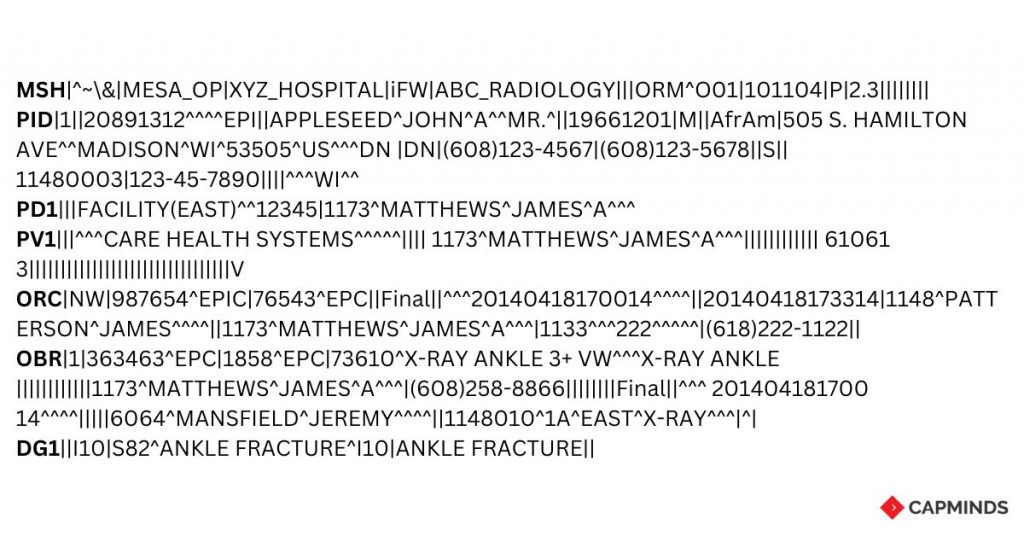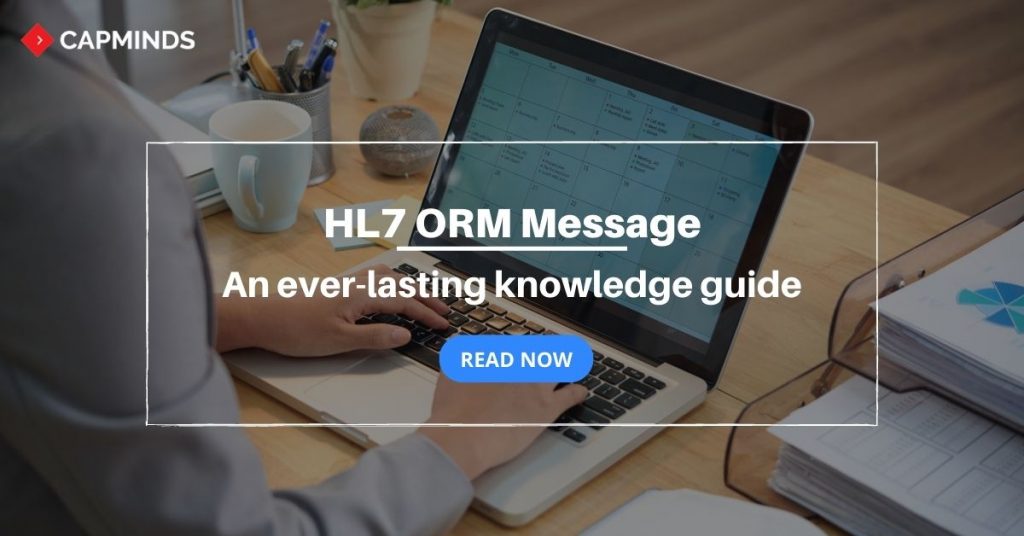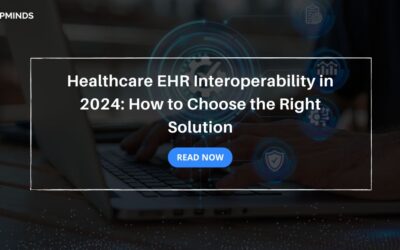HL7 ORM Message: An ever-lasting knowledge guide
HL7 messages act as a medium and work as consolidated sources of information. This is to create a secure mechanism for exchanging sensitive health data which is vulnerable to hacking.
As we speak now, more than 92% of the US health institutes use HL7, and its widespread adoption in at least 27 countries made it a global standard. HL7 message has many examples but the ORU message is a supreme and uppermost method of sharing information.
This article covers the following contents;
- HL7: Covering the Term
- HL7 Standard
- HL7 Message Types [the most used]
- What is HL7 ORM Message?
- What are the types of ORM Messages (orm^001)?
- HL7 ORM Message Segments
- Special Functional Specifications
- Example of HL7 Version 2.3 ORM^001 message
- What Are The Contents Of An HL7 ORM Message?
- HL7, Interoperability services from CapMinds
HL7: Covering the Term
- Health Level Seven (HL7) – a healthcare electronic data exchange standard.
- Provides – standardized format & protocols for the transfer of health data across healthcare systems.
- It is flexible and allows different systems to exchange patient information as needed.
- It is also an organization with tech committees and special interest groups.
- The organization’s focus – providing standards for the management, integration, and exchange of healthcare services.
- Facilitates – flexibility, budget-friendly approaches, guidelines, standards, methods, and more for achieving secured interoperability between health information systems.
HL7 Standard
- Directs the interfaces among different systems that exchange health information (like admissions, registration, queries, discharge data, billing, etc.).
- Does not try to presume a particular structure about the placement of data within applications.
- It is designed to assist a common patient care system and a more dispersed environment where data are held in departmental systems.
- HL7 is a way for letting different apps and data structures function in a diverse system environment to communicate with each other.
HL7 Message Types [the most used]
- ADT – Admit, Discharge, Transfer
- ACK – General acknowledgment
- DFT – Detailed Financial Transaction
- BAR – Add/change billing account
- MDM – Medical Document Management
- MFN – Master Files Notification
- QRY- Query, original mode
- ORM – Order (pharmacy/treatment)
- ORU – Observation result (unsolicited)
- RDE – Pharmacy/treatment encoded order
- RAS – Pharmacy/treatment administration
- RGV – Pharmacy/treatment give
- SIU – Scheduling Information Unsolicited
RELATED: HL7 ORU Message: An in-depth guide that you cannot miss
What is HL7 ORM Message?
- HL7 ORM (Order entry) messages are a common message type used to enable orders within radiology & laboratory departments.
- The message contains information on a request for a service or material.
- These messages can be used for a medical department like an emergency ward or as a resource for education.
What are the types of ORM Messages (orm^001)?
There is only one type of ORM message – the ORM 001 message.
- This message commences the communication of information about an order.
- It includes giving new orders, canceling existing orders, updates, holding, discontinuation, etc.
- The message can also arise with a placer, filler, or a third party.
HL7 ORM Message Segments
MSH – Message header segment
NTE – Notes and comments segment
PATIENT
- PID – Patient Identification
- PD1 – Patient Demographic
- NTE – Notes and comments segment
- PATIENT VISIT
- PV1 – Patient visit
- PV2 – Patient visit (extra information)
- INSURANCE
- IN1 – Insurance
- IN2 – Insurance (extra information)
- IN3 – Insurance – extra information – certification
- GT1 – Guarantor
- AL1 – Patient Allergy Information
ORDER
ORC – Common order segment
- ORDER DETAIL
- ORDER DETAIL SEGMENT
- NTE – Notes and comments segment
- DG1 – Diagnosis
- OBSERVATION
- OBX – Observation segment
- NTE – Notes and comments segment
- CTI – Clinical Trial Identification
- BLG – Billing
- ORDER DETAIL SEGMENT
Special Functional Specifications
- ORM messages have a PID segment like ADT messages (used to pass on parts of a patient’s Patient Administration (ADT) data between systems). The PID segment provides patient identification information. In the ORM message, the PID segment is only needed in case of new orders only when they are of a single patient.
- The OBX segment in the ORM message is a part of an optional and repeatable group called the Observation group. It contains clinical information required by the receiving system to clarify the observation that will be made instead of information about results & observations like in the (ORU message).
Example of HL7 Version 2.3 ORM^001 message

What Are The Contents Of An HL7 ORM Message?
HL7 ORM messages are commonly used to make Radiology & lab orders. An ORM message like the HL7 message structure is made up of segments and groups of segments. These segments may be required, optional, repeatable, or a combination of these.
- [ ] – Optional
- { } – Repeating
- [{ }] – Optional repeating
- No brackets – Required
HL7, Interoperability services from CapMinds
CapMinds Technology offers the perfect all-in-one Health Interoperability solutions for your clinical needs. Our HL7 FHIR integration services help the innovatory exchange to create new possibilities. Our client-centered services keep them in the limelight. Our clinical integrations have EHR-integrated laboratory, imaging, e-prescriptions, EPCS, pharmacy, and much more. These enhance the activation process for your individual and collective needs.
“CapMinds Technology helps you achieve your goals by combining “Expertise+Hard work+Commitment”.
CapMinds FHIR services cover your health data with more security, privacy, and confidentiality. We update ourselves with the latest versions like HL7 Version 2, Version 3, FHIR, SMART on FHIR, CDA, X12, Mirthconnect, and security standards. CapMinds offers the best HL7 integration & HL7/FHIR interface development services for the federal government, health tech startups, laboratories, clinics, and practices.
“Unite with us to enjoy the benefits with our HL7 & interoperability services and rise to be the first”




